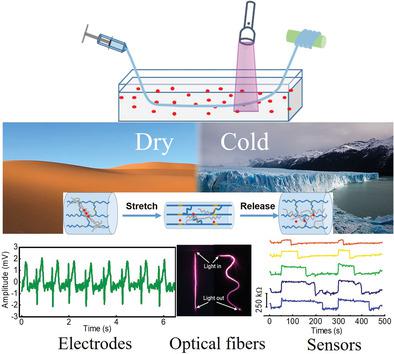当前位置:
X-MOL 学术
›
Adv. Mater.
›
论文详情
Our official English website, www.x-mol.net, welcomes your feedback! (Note: you will need to create a separate account there.)
Mechanically and Electronically Robust Transparent Organohydrogel Fibers
Advanced Materials ( IF 29.4 ) Pub Date : 2020-01-19 , DOI: 10.1002/adma.201906994 Jianchun Song 1 , Shuo Chen 1 , Lijie Sun 1 , Yifan Guo 1 , Luzhi Zhang 1 , Shuliang Wang 1 , Huixia Xuan 1 , Qingbao Guan 1 , Zhengwei You 1
Advanced Materials ( IF 29.4 ) Pub Date : 2020-01-19 , DOI: 10.1002/adma.201906994 Jianchun Song 1 , Shuo Chen 1 , Lijie Sun 1 , Yifan Guo 1 , Luzhi Zhang 1 , Shuliang Wang 1 , Huixia Xuan 1 , Qingbao Guan 1 , Zhengwei You 1
Affiliation

|
Stretchable conductive fibers are key elements for next‐generation flexible electronics. Most existing conductive fibers are electron‐based, opaque, relatively rigid, and show a significant increase in resistance during stretching. Accordingly, soft, stretchable, and transparent ion‐conductive hydrogel fibers have attracted significant attention. However, hydrogel fibers are difficult to manufacture and easy to dry and freeze, which significantly hinders their wide range of applications. Herein, organohydrogel fibers are designed to address these challenges. First, a newly designed hybrid crosslinking strategy continuously wet‐spins hydrogel fibers, which are transformed into organohydrogel fibers by simple solvent replacement. The organohydrogel fibers show excellent antifreezing (< ‐80 °C) capability, stability (>5 months), transparency, and stretchability. The predominantly covalently crosslinked network ensures the fibers have a high dynamic mechanical stability with negligible hysteresis and creep, from which previous conductive fibers usually suffer. Accordingly, strain sensors made from the organohydrogel fibers accurately capture high‐frequency (4 Hz) and high‐speed (24 cm s−1) motion and exhibit little drift for 1000 stretch–release cycles, and are powerful for detecting rapid cyclic motions such as engine valves and are difficult to reach by previously reported conductive fibers. The organohydrogel fibers also demonstrate potential as wearable anisotropic sensors, data gloves, soft electrodes, and optical fibers.
中文翻译:

机械和电子稳健的透明有机水凝胶纤维
可拉伸的导电纤维是下一代柔性电子产品的关键要素。现有的大多数导电纤维都是基于电子的,不透明的,相对刚性的,并且在拉伸过程中显示出电阻的显着增加。因此,柔软,可拉伸和透明的离子导电水凝胶纤维备受关注。然而,水凝胶纤维难以制造并且易于干燥和冷冻,这极大地阻碍了其广泛的应用范围。在本文中,设计有机水凝胶纤维以应对这些挑战。首先,一种新设计的混合交联策略连续湿纺水凝胶纤维,通过简单的溶剂替代即可将其转变为有机水凝胶纤维。有机水凝胶纤维具有出色的抗冻能力(<-80°C),稳定性(> 5个月),透明性,和可拉伸性。主要的共价交联网络可确保纤维具有高动态机械稳定性,而滞后和蠕变可忽略不计,以前的导电纤维通常会遭受这些损害。因此,由有机水凝胶纤维制成的应变传感器可准确捕获高频(4 Hz)和高速(24 cm s-1)运动,并且在1000次拉伸释放循环中几乎没有漂移,并且对于检测快速循环运动(例如发动机气门)非常有力,并且以前报道的导电纤维很难达到。有机水凝胶纤维还具有作为可穿戴各向异性传感器,数据手套,软电极和光纤的潜力。
更新日期:2020-02-24
中文翻译:

机械和电子稳健的透明有机水凝胶纤维
可拉伸的导电纤维是下一代柔性电子产品的关键要素。现有的大多数导电纤维都是基于电子的,不透明的,相对刚性的,并且在拉伸过程中显示出电阻的显着增加。因此,柔软,可拉伸和透明的离子导电水凝胶纤维备受关注。然而,水凝胶纤维难以制造并且易于干燥和冷冻,这极大地阻碍了其广泛的应用范围。在本文中,设计有机水凝胶纤维以应对这些挑战。首先,一种新设计的混合交联策略连续湿纺水凝胶纤维,通过简单的溶剂替代即可将其转变为有机水凝胶纤维。有机水凝胶纤维具有出色的抗冻能力(<-80°C),稳定性(> 5个月),透明性,和可拉伸性。主要的共价交联网络可确保纤维具有高动态机械稳定性,而滞后和蠕变可忽略不计,以前的导电纤维通常会遭受这些损害。因此,由有机水凝胶纤维制成的应变传感器可准确捕获高频(4 Hz)和高速(24 cm s-1)运动,并且在1000次拉伸释放循环中几乎没有漂移,并且对于检测快速循环运动(例如发动机气门)非常有力,并且以前报道的导电纤维很难达到。有机水凝胶纤维还具有作为可穿戴各向异性传感器,数据手套,软电极和光纤的潜力。

























 京公网安备 11010802027423号
京公网安备 11010802027423号